Complete Guide To Train Travel In Europe
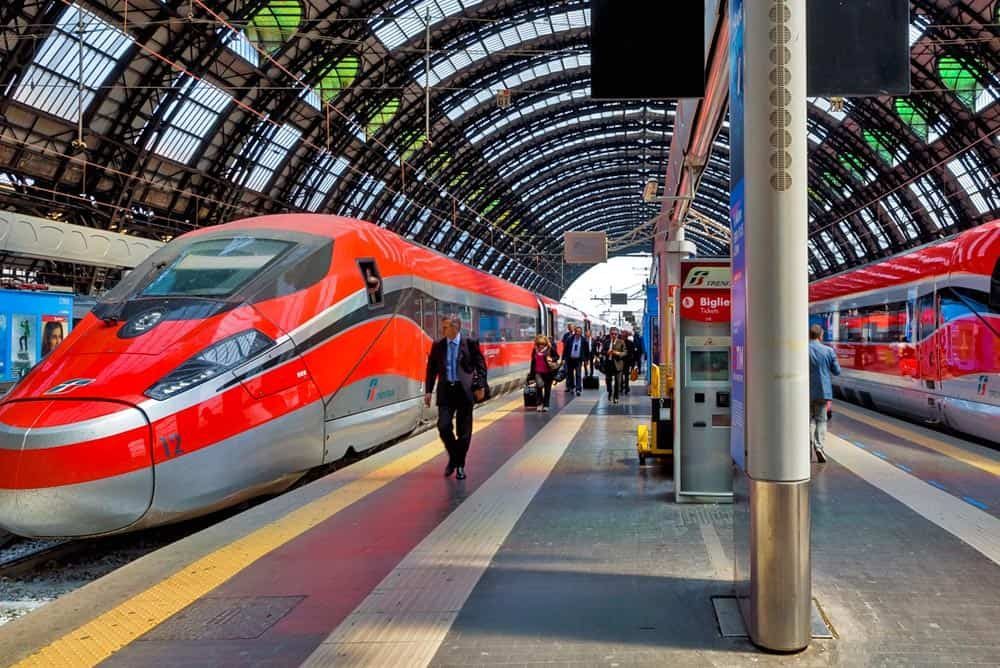
Traveling by train is the quintessential way to tour Europe. It’s romantic. It’s inspiring. It’s super-efficient. It’s comfortable. Some might say it’s almost magical. And to those who don’t live in a country where train travel is prominent, it’s a little mysterious.
In this Complete Guide To Train Travel In Europe, I’ll cover everything you need to know about traveling Europe by rail—including how to get the best price on train tickets, rail passes, understanding train schedules, tips for riding trains, how to navigate train stations, and advice for dealing with other issues you might encounter. By the end of this guide, you’re going to be a European train expert!
Quick Tip: Most train tickets are now electronic so you’ll want fast and reliable mobile data on your phone when traveling via train. Check out my guide on how to use your phone in Europe and our guide to the best SIM Cards and Data Plans for Europe.
Europe Train Travel: The Good & Bad
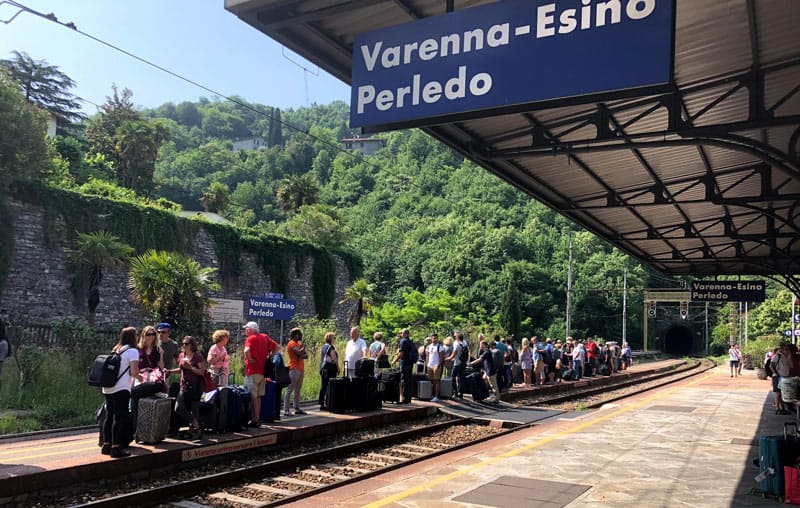
Let’s start with a quick overview of the good and the not-so-good aspects of European train travel.
Advantages Of Train Travel In Europe
Here are all the things I love about riding the train in Europe:
- You Arrive/Depart From The City Center
- Unlike airports, European train stations are located right in the middle of town. You don’t have to spend time and money traveling into the city because you’re already there.
- In contrast, traveling from the airport to the city can take anywhere from 20-60 minutes and costs between $10-$80.
- Unlike airports, European train stations are located right in the middle of town. You don’t have to spend time and money traveling into the city because you’re already there.
- No Long Check-In and Security Lines
- There are no lengthy check-in procedures or security screening for most train travel. You simply show up a few minutes before the train leaves, buy a ticket if you don’t have one (often from a ticket machine with English instructions), and hop on the train.
- No Luggage Limits/Fees
- There are no luggage weight limits or extra fees for multiple pieces of luggage. Just make sure that you’re able to lift your bag onto the train.
- E-Tickets
- Most European trains now accept electronic tickets—you simply show your ticket on your phone. That means no waiting in ticket lines and it makes planning your train travel even easier.
- Bring A Picnic (Don’t Forget The Wine and Beer)
- You can pretty much bring whatever you want on a train—including alcohol. You’re sure to make a few friends if you give a few away to your fellow travelers. So stop by the local grocery store and pick up some cheap food for the journey.
- A Vast Rail Network and Multiple Trains
- Europe’s rail network is extremely vast so it is possible to travel to even small towns by train. Most destinations offer multiple trains a day. The most popular routes usually have multiple trains an hour so getting to where you want to go is rarely difficult.
- Sleep On the Train and Extend Your Travel Time
- If you’re traveling a long distance, consider taking an overnight train. These trains have special sleeper cars with bunks (usually six-bunk rooms or two-bunk rooms). A bunk in a sleeper car will cost about $35-$65 extra (about the same as a night in a hostel) but you won’t lose out on a whole day of travel. Overnight trains also have normal seats if you don’t want to fork over the extra cash for a bunk but it’s kind of uncomfortable.
- Spontaneous Travel
- Train travel allows you to be spontaneous so you can show up at any train station, buy a ticket, and be on your way.
- Beautiful Views
- Europe has a lot of beautiful countrysides so traveling by train is a great way to see some fantastic views.
- Peace and Quiet
- The train is the perfect place to sit back and relax. There is something very peaceful about staring out the window as you ride silently at 170MPH through the European countryside. The train is also a good time to write a postcard to your friends and family, read a book, write in your journal (you’ll be glad you did), or continue planning your future travels.
- Some trains also offer designated quiet cars if you truly want to relax.
- The train is the perfect place to sit back and relax. There is something very peaceful about staring out the window as you ride silently at 170MPH through the European countryside. The train is also a good time to write a postcard to your friends and family, read a book, write in your journal (you’ll be glad you did), or continue planning your future travels.
- Comfort
- Train seats are larger and more comfortable than plane seats (especially when compared to many discount airlines). You’re also free to move about the train whenever you feel like it. Many trains also have seats that face each other and have a table between the seats—so it’s great for groups.
- Reliable and On Schedule
- European trains run on schedule well over 90% of the time but flights are only on schedule around 65%.
- Beautiful Train Stations
- Historically, train stations were the central hub for commerce and transportation so European cities showed off their status by building grandiose train stations. While it isn’t a huge deal, it is one of those nice little perks.
- Youth Discounts
- Many countries offer sizable discounts for people under 26 years old so don’t forget to look into those discounts.
- The Train is Fun
- We’ve always found riding the train to be fun. It’s oddly magical and relaxing.
Disadvantages of Train Travel in Europe
Train travel isn’t perfect so here are a few things to watch out for:
- The Cost
- Train travel can be expensive—especially on high-speed trains. Furthermore, there are a lot of super-cheap flights throughout Europe so flying can often be cheaper.
- That said, you can get some really good deals if you’re able to book high-speed trains in advance. But you’ll pay a premium if you book super last minute.
- There are often discounts for travelers under 26 years old.
- Train travel can be expensive—especially on high-speed trains. Furthermore, there are a lot of super-cheap flights throughout Europe so flying can often be cheaper.
- Slow for Long-Distance Travel
- Many high-speed trains often travel between 150-180MPH but very long distances can still take quite a bit of time. Additionally, some long-distance routes might require the use of slower regional trains.
- That’s why it might make more sense to fly if you’re traveling long distances. For example, taking the train from Paris straight to Budapest would take around 15 hours by train but only 2.5 hours by plane (plus, flying would be considerably cheaper).
- Note: Don’t forget to add in travel time to/from the airport and time to get checked in and through security—which will add around two-three hours to your journey.
- Slightly Confusing
- The train schedules can be a little confusing—especially for beginners. Luckily, there are plenty of apps that help make the process much easier but we still get tripped up every now and then.
- Many cities have more than one train station (Paris has six!). It’s not uncommon to arrive at one station and leave from another. We’ve shown up at the wrong station a number of times so be sure you read your tickets carefully.
- It is also possible to change stations during a single journey. For example, when traveling from London to Lyon via the Eurostar, the Eurostar stops at the Paris North station, but then you have to travel to the Paris East station to catch the train from Paris to Lyon because there are no direct trains from London to Lyon. This transfer would require a cheap Métro (subway) ride.
- Rail Strikes
- Striking is a national pastime in Europe. It happens a few times a year (or more if the people aren’t happy) but they announce the strikes well in advance so it shouldn’t be a surprise (just a hassle). You’ll just have to deal with them if they happen.
Pre-Trip Train Journey Planning
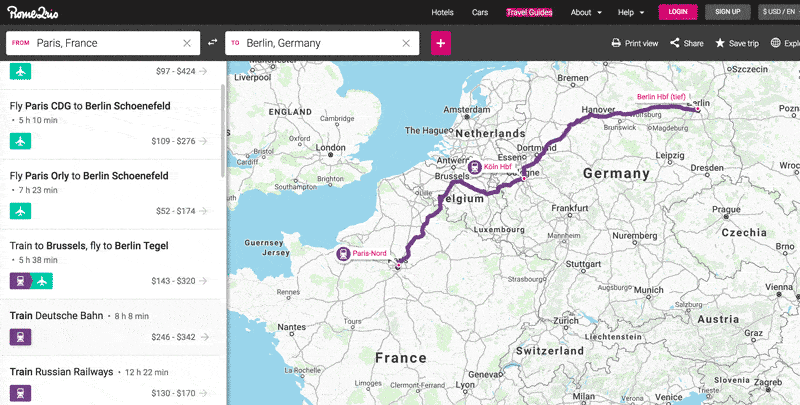
There are a number of great websites that will help you plan your train journey.
The first is Rome2Rio — simply plug in your destinations and it will give you all the train routes (as well as plane, bus, and car routes with cost estimates and travel times) for your journey. Rome2Rio is good for comparing different modes of transportation but I find better train ticket prices and more complete train listings on Omio and Trainline.
The German Railways Website (Bahn.de) shows the schedule of every train in Europe (yes, every train). We find that it’s helpful for piecing together complex train journeys. But it’s also good for seeing which trains require reservations and other important information. Unfortunately, you can only book German train tickets on the site so hop over to Omio and Trainline to book your tickets.
I’ve also written a few country-specific train guides to help you learn the quirks of each country’s rail network.
How to Buy European Train Tickets
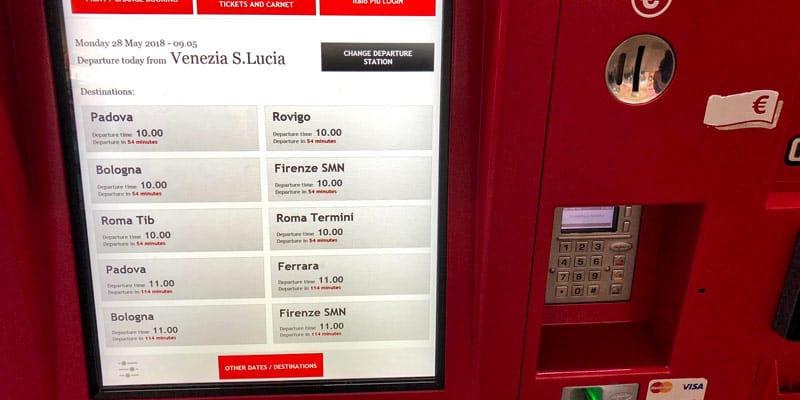
Buying European train tickets can be a little complicated—especially when you’re looking for the best deals.
That’s because each country runs its own National rail service (many countries also have separate private rail networks as well) and each does things slightly differently. Luckily, there are plenty of online tools to make the whole process easier and we’ll walk you through the process.
Understanding Train Ticket Pricing
Before we get started, we need to explain that there are two main ways that train tickets are priced — fixed price and variable price.
Variable-Price Train Fares
Variable Fares are always changing based on demand, the day of the week, the time of year, and the distance to the departure date. Essentially all high-speed trains operate on this pricing model.
- To get the best price on high-speed train tickets it’s best to pre-book your tickets early — usually a few weeks in advance. In general, the prices will continue to creep up as the departure date approaches — you’ll pay a fortune if you buy last minute.
- Of course, you lose flexibility if you have to buy tickets in advance because the cheapest tickets are normally non-refundable/unchangeable
Fixed-Price Train Fares
With Fixed Fares, the price is solely determined by the distance traveled. This is most common on regional and slower trains. With this type of ticket, it doesn’t matter when you buy your tickets because the price never changes.
Where To Buy Europe Train Tickets
There are two main ways to buy European train tickets — directly from each country’s National Rail Service (via their website or at the train station) or through a third-party train booking search engine like Omio and Trainline—I find these booking services to be much more user-friendly.
Third-Party Booking Sites
There are quite a few advantages to buying your train tickets with third-party booking sites:
- Booking Complex or Multi-Country Routes
- The advantage of booking with a third-party booking site is that it lets you book more complex multi-country/international train routes. Many National Rail Services have trouble booking international routes (i.e. going from France to Italy) — so they can’t always find the best deals or show all available routes.
- No Credit Card Processing Issues
- Many of Europe’s National Rail websites still have issues processing foreign credit cards so it’s common for credit cards to be declined when booking. These third-party sites won’t have these issues.
- No Weird Technical or Translation Issues
- We’ve found that it’s common for Europe’s National Rail websites to be plagued with weird technical problems and overall poor user interfaces. Many times you’ll get kicked from the English version of the page to the local language in the middle of the booking process. These third-party booking websites take care of these issues.
Our Favorite Train Booking Websites
- Omio: Omio is a great train booking engine that lets you book tickets from just about every country’s rail service and they make the booking process very user-friendly.
- Trainline.com: Trainline is a new European train booking service (very similar to Omio) that sells train tickets from Austrian, French, German, Spanish, Italian, and German Railways railways (and a few others).
National Booking Sites
Despite their technical issues, sometimes the absolute cheapest tickets can only be found by booking directly with each country’s national rail service. This is because sometimes they offer are special deals that the third-party booking sites don’t have access to. So it doesn’t hurt to at least take a look.
Links to Some National Railway Websites:
Austrian Railways¹ – Belgian Railways¹ – Danish Railways – Finnish Railways – French Railways – German Railways – Irish Railways – Italian Railways – Spanish Railways – Netherlands Railways¹ – Norwegian Railways – Polish Railways – Swedish Railways – Swiss Railways¹ – United Kingdom Railways
¹ Domestic tickets (i.e. trips that are wholly within the country) are always the same price — regardless of when they’re purchased and they never require a reservation. Therefore, it is easiest to buy tickets at the station. However, these countries often have a separate international high-speed train system (e.g., Belgium has slower regional trains and high-speed Thalys trains that link major Belgian cities to other international cities — these tickets should be purchased early for cheaper fares).
Quick Note About Eastern Europe Trains
Some Eastern European countries still don’t have online ticket booking so it’s only possible to purchase tickets at the station or through a local travel agent. Ask your hostel or hotel and they’ll tell you where to locate an agent.
Receiving Your Online Tickets
There are a number of ways to collect your tickets after you purchase them:
- Electronic Tickets: Many times you can have an electronic ticket sent to your phone (either via email or the booking app). Simply show the conductor on the train when he checks tickets and he’ll scan the QR code on the screen. This isn’t available in all countries but most countries have switched to eTickets.
- Print-At-Home Tickets: Anywhere that offers electronic tickets will usually let you print tickets at home. You can often simply save the PDF to your phone/tablet and the conductor can scan it from there.
- Pick Up At the Station: Use your credit card or a booking number to print your tickets at the train station ticket machines.
- Note: You’re often required to use the SAME credit card use to purchase the tickets to collect the tickets at the station.
Buying Tickets At The Station
You can buy train tickets at any train station—either from the ticket window or from automated ticket machines. We recommend trying the automated ticket machines since the lines at the ticket window are long, slow, and understaffed.
When To Buy Train Tickets To Get The Best Price
Fares are fixed for most regional and local trains so there is no reason to buy them early.
For high-speed trains, it’s best to buy tickets early to get the cheapest tickets. In most cases, train tickets can be purchased 60-90 days before the departure date but buying a few weeks early is usually fine.
Let’s look at some ticket price examples:
- Paris to Nice
- Purchased Two Days Before Departure: €69.00
- Purchased Three Weeks Before Departure: €55
- Paris to Amsterdam
- Purchased Two Days Before Departure: €135
- Purchased Three Weeks Before Departure: €97
- Purchased Six Weeks Before Departure: €54
- London to Paris (Eurostar Train)
- Purchased Two Days Before Departure: €234
- Purchased Three Weeks Before Departure: 124
- Purchased Six Weeks Before Departure: €55
As you can see, booking just a few weeks early can save quite a bit of money.
Quick Point About Buying Train Tickets Early: As stated above, buying tickets in advance is the best way to save money but this also limits your ability to be flexible/spontaneous. This is especially true since many of the truly cheap train tickets are non-refundable. For optimum flexibility, it might be best to buy a rail pass. Here’s our Guide To Using Rail Passes in Europe and our Eurail Pass Review.
Other Train Ticket Discounts
Most rail services offer various discounts—some are based on rider age but other discounts are based on region, the day of the week, or other schemes.
- Youth Discount
- The most common discount is a youth discount — which is usually for people under 27 years old.
- Country-Specific Discounts
- Most countries offer a number of potential discounts. For example, Germany has a Schönes-Wochenende-Ticket (Happy Weekend Ticket) where groups of 2-5 people can ride as much as they want on regional trains from Saturday-Sunday for €44. Check each country’s rail service website to see if there are discounts available.
Eurail Passes
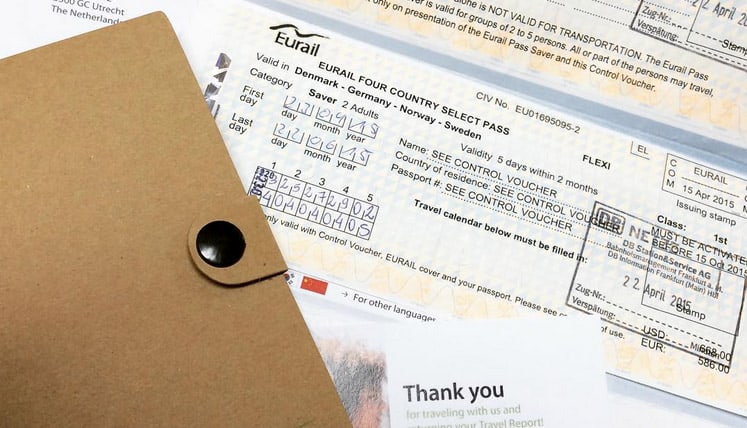
Many travelers choose to use rail passes instead of buying individual tickets. That’s because Eurail passes can save you a bit of money (depending on how you use them) but most importantly they give you excellent flexibility by allowing you to travel without needing to plan.
Note: We’ve written a lot about Eurail Passes. Check out our Guide To Using Rail Passes in Europe and our Eurail Pass Review for more in-depth information.
Quick Rundown On Rail Passes
A rail pass (aka Eurail Pass) is a single ticket/pass that allows you to ride any train in Europe — simply hop on, show the conductor your pass, and you’re good to go. Actually, it’s not quite that easy these days as there are a few stipulations, but the general idea is that you can ride any train without booking individual tickets.
Types Of Rail Passes
- Global Pass
- Continuous: Unlimited travel to any Eurail participant country for between 15 days and 3 months.
- Flexi: 10 or 15 individual travel days (doesn’t have to be consecutive days) to any Eurail participant country within a two-month period.
- Select Pass:
- Between 5 and 15 travel days in a two-month period, but you’re limited to traveling to 3, 4, or 5 bordering countries. These passes are good if you have a group of countries you’re interested in visiting.
- For example, one pass could be 10 days of train travel between France, Switzerland, and Italy. You have a two-month window to use of your 8 travel days. Each day you travel by train counts as one travel day but you can take unlimited train rides within each day.
- Between 5 and 15 travel days in a two-month period, but you’re limited to traveling to 3, 4, or 5 bordering countries. These passes are good if you have a group of countries you’re interested in visiting.
- Single-Country Pass:
- Eight travel days in a single country which must be used within a month.
Advantages of Rail Passes
- Flexibility: The number one benefit of rail passes is the flexibility they offer. You simply have to walk onto the train and go. That’s why this is a great option for people who don’t want to plan and who would rather wander across Europe.
- Long-Distance Trains: It’s also a good deal if you plan on taking a lot of long-distance trips because those tickets tend to be expensive so a rail pass is a good way to save some money. On the other hand, if you’re taking a bunch of short train rides then you’ll probably be better off buying single tickets.
- Low Stress: Piecing together a bunch of train journeys and then pre-purchasing individual tickets is stressful and take a lot of time and planning. For a lot of people paying a little extra for a rail pass is worth the hours saved having to preplan your entire trip.
Disadvantages of Rail Passes
- More Expensive: It’s usually cheaper if you purchase your train tickets online a few weeks in advance. That said, most of these cheap pre-purchased tickets are non-refundable so you’ll lose most of your flexibility. However, if you’re purchasing your train tickets a few days before departure then it’s much cheaper to use a rail pass.
- Reservations: A few countries require rail pass holders to pay extra for a seat reservation on high-speed trains. The fee can range from anywhere from €5-€35 and they have to be made in advance — they can sometimes be made online or directly at the train station. Here’s a detailed guide to rail pass reservation requirements from eurail.com. You can also enter your journey into Bahn.de and it will tell you if that specific journey requires a reservation.
At The Train Station
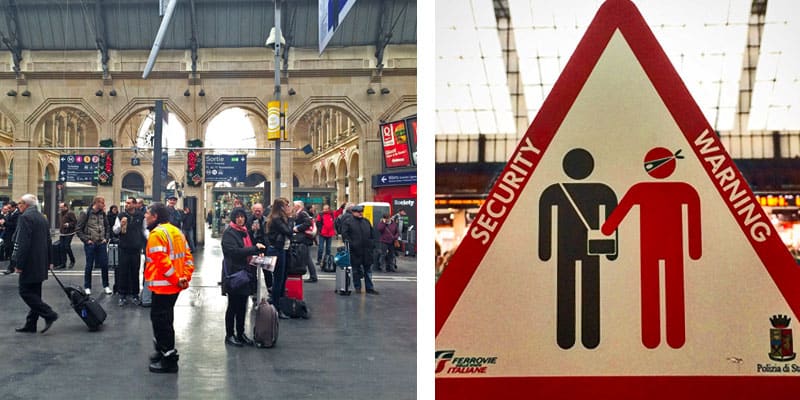
Ok, now we know about buying train tickets and rail passes and all that jazz… so let’s learn about what to expect when you get to the train station.
The train station is the central transportation hub of most European cities so things can be a little chaotic and confusing—especially if you’re not used to traveling by train. In this section, we’ll give you some tips to help you find your train.
Navigating The Train Station
First, make sure you have the correct train station because many cities have multiple stations. For example, Paris has six stations, and even smaller towns have two different stations.
Once you arrive at the station, you’ll see signage in English so you shouldn’t have much trouble finding your way. Some stations are huge so you may have to walk quite a bit and navigate stairs and escalators.
Depending on the size of the station, you’ll also find fast food, cafes, shopping, lounges, and restrooms (although you sometimes have to pay to use them). We usually pick up something to drink and maybe a little snack for the train. Also, most train stations have luggage lockers that you can rent if you need them.
Pickpockets and Scams at the Train Stations
Train stations can get very busy, hectic, and full of confused tourists so they’re a common target for pickpockets and other scammers. Pay attention to your stuff and be wary of “helpful” strangers willing to help you with the ticket machines. Check out our Guide To Avoiding Pickpockets and Tourist Scams in Europe.
Train Ticket Machines
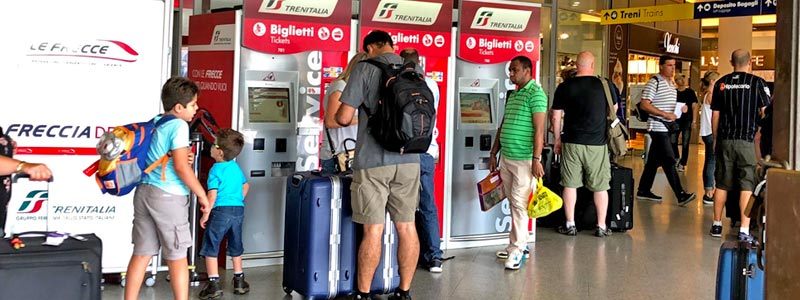
If you need to buy your train tickets or print your pre-purchased tickets you’ll want to first head to the automated ticket machines. Everything is in English are the machines are easy-to-use.
Alternatively, you can still go to the ticket window or customer service desk but the lines are usually long.
Reading The Departure Board
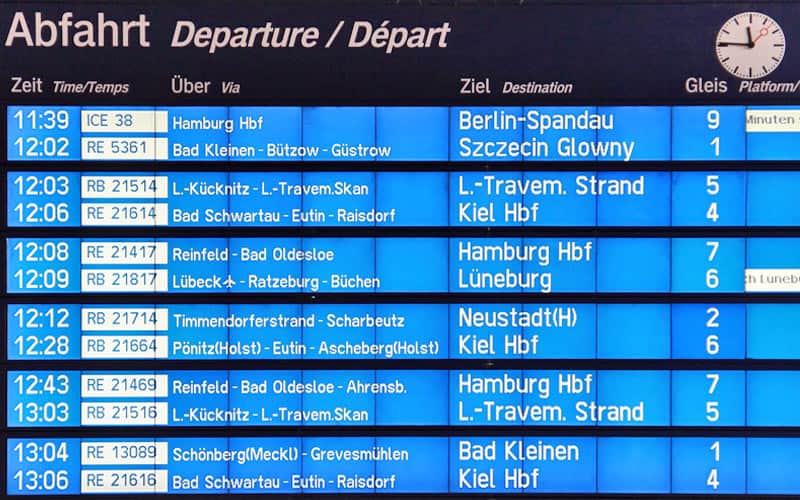
Once you arrive at the station you’ll want to look for the departure board. There are usually multiple boards throughout the station and one giant main board. This board tells you where to find your train, when it leaves, and where it’s going.
The three most important things to note are the train number, departure time, and the platform.
Your train ticket will show the scheduled departure time and the train number but it usually won’t show which platform the train leaves from. You’ll want to find the train number on your ticket and match it up to the departure board. It’s very common for the departure board to not show the platform until a few minutes before departure so pay attention to the board.
Find Your Train’s Platform
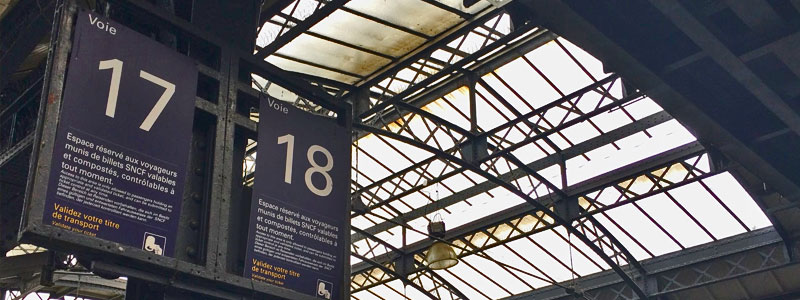
Once know what platform your train is departing from you’ll want to find that platform at the station. Sometimes the platforms are a bit hard to find so you might have to seek them out. Don’t worry if there isn’t a train there at the moment because trains often pull in, load up, and leave.
There are usually a few staff members milling about on each platform so don’t be afraid to ask train station staff as most can speak English.
Validate Your Ticket
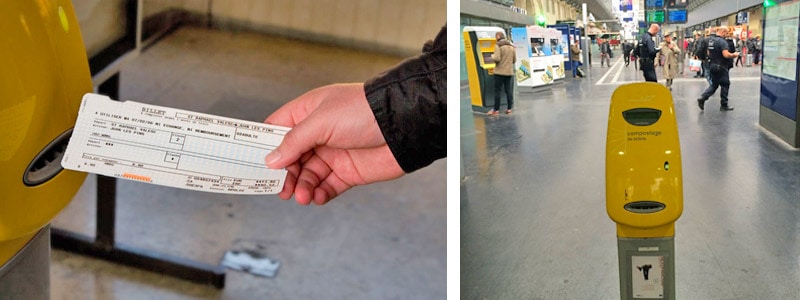
Many physical train tickets need to be validated (stamped with time/date) before entering the train so look for small validation boxes near the entrance of the platforms. Simply place your ticket inside the machine and it will stamp it.
You can receive a large fine if the ticket checker sees that your ticket isn’t validated (they’ll assume you were trying to ride for free). If you forgot, quickly seek out the conductor, explain that you forgot to validate and everything should be fine. Or you can just play the “I’m a dumb tourist and these scary trains confuse me” card and hope they let it slide.
Note: Electronic tickets don’t need to be validated because they’re usually only good for the specific time stated on your ticket. Some paper tickets also don’t need to be validated but we usually try doing it anyway to be safe.
Finding Your Train Car
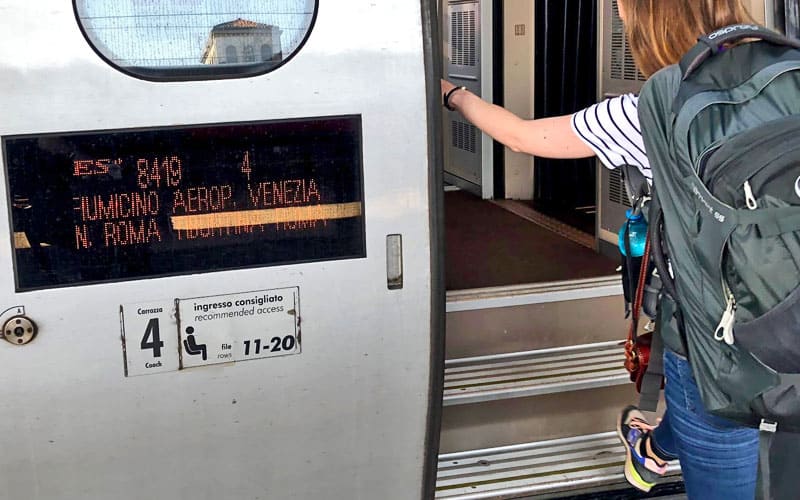
On some trains (usually high-speed trains) you have assigned seats so look at your ticket to see which train car your seat is in. The car number will be displayed on the side of each train car. You can enter in any car but it’s much easier if you enter your car (walking through multiple train cars is a pain).
Most regional and slower trains don’t have assigned seats so you can simply hop on any car.
That said, you’ll want to get on fairly quickly because trains are usually only at the station for a few minutes before they leave.
On The Train

You’ve made it on the train. Congratulations! In this section, we’ll talk about settling in and a few things you might experience on your ride.
Find Your Seat & Store Luggage
Find your assigned seat (if you have one) or take any free seat if it’s open seating. Also, take the opportunity to store your luggage. Smaller luggage like backpacks and some suitcases can be stored above your seat on luggage racks. There are usually larger spaces for bigger luggage at the end of each train car.
Wait For The Conductor To Check Your Tickets
After the train starts, a ticket checker will come by and check your ticket. While not extremely common in Western Europe, border patrol might board the train to check passports. They might ask you some questions but we usually only ran into this in Eastern Europe.
Enjoy The Ride
One of the great things about train travel is the comfort of the ride. Feel free to walk about, check out the bar car, enjoy a picnic (alcohol is allowed), or sleep. Some trains offer free wifi but we’ve never had much luck getting it to actually work.
Departing The Train
One of the most confusing parts of the ride is knowing exactly when to leave the train. That’s because train stations are sometimes named very similarly. For example, many trains coming into Brussels first stop at the Brussels Nord station (which is located on the outskirts of town) before stopping at the main Brussels Centrale station (which is located in the center of town).
More Europe Travel Tips From The Savvy Backpacker

We have a lot more tips and tricks for traveling through Europe on a budget. Here are a few helpful articles we think you’ll enjoy.

No Funny Business
The Savvy Backpacker is reader-supported. That means when you buy products/services through links on the site, I may earn an affiliate commission—it doesn’t cost you anything extra and it helps support the site.
Thanks For Reading! — James
Questions? Learn more about our Strict Advertising Policy and How To Support Us.

